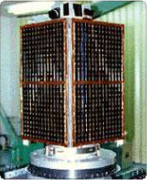닫기
| 인공위성연구센터 소개 | 인공위성관련 정보 | 연구개발 | 인력 양성 | 연구개발시설 | 산업기술지원 | 정보나눔 |
|---|---|---|---|---|---|---|
|
인사말 설립목적과 비전 연혁 조직도 찾아오시는 길 |
인공위성소개 - 인공위성 개요 - 주요 임무 - 내부구조 - 위성체조립 - 환경시험 - 발사 위성개발역사 |
우리별 위성 개발 - 우리별 1호 - 우리별 2호 - 우리별 3호 과학기술위성 개발 - 과학기술위성 1호 - 과학기술위성 2호 - 나로과학위성 - 과학기술위성 3호 차세대 소형위성 개발 초소형위성 군집시스템 개발 핵심우주기술 개발 - 다기능 구조체 - 고성능 탑재컴퓨터 개발 - 홀 추력기용 연료공급장치 - 리튬-이온 배터리 - 초소형 영상 분광기 - 고속데이터 시뮬레이터 과거수행 프로젝트 |
캔위성 체험·경연대회 뉴스페이스 리더 양성 - 사업 개요 - 사업 운영 - FAQ |
지상국 청정실 진동시험기 열진공 챔버 |
환경시험지원 - 진동시험 - 열진공/주기시험 |
공지사항 채용공고 사진자료실 |
| 전체메뉴닫기 | ||||||

Research and Development
KITSAT-2
▶ HOME > Research and Development > KITSAT Series > KITSAT-2

∎ KITSAT-2
Launched in August 1993, KITSAT-2 was Korea’s second satellite and the first domestically developed and manufactured satellite.Upon returning to Korea, the researchers who led the KITSAT-1 project worked with domestic research teams to conduct the entire development process independently at SaTReC, from mission analysis, design and manufacture, to testing.
KITSAT-2 carried out missions such as earth observation and space plasma measurement. Experience gained from the KITSAT-2 project gave domestic researchers confidence in satellite research as they independently developed solutions for the various challenges involved in satellite development.
- To improve the KITSAT-1 system and acquire independent development capabilities
- Maximum utilization of domestically manufactured components
- To test domestically developed experimental modules
- To promote the development of the domestic space industry
| Orbit | 800 km circular sun-synchronous orbit (inclination 98.57o) |
| Size | 352x356x670 mm |
| Weight | 47.5 kg |
| Power Rating | Max. 30 W |
| Attitude Control Method | Gravity-gradient stabilization, magnetic torquer, < 5 deg pointing accuracy |
| Communication (Transfer Speed) |
Uplink (145 MHz frequency band): 9600bps Downlink (436 MHz frequency band): 9600bps |
| Main Computer | OBC186(80C186) |
| Payloads |
CCD Earth Imaging System (CEIS) Next Generation Small Satellite Computer High Speed Modulation Experiment Device Digital Store and Forward Communication Experiment (DSFCE) Low Energy Electron Detector (LEED) |


